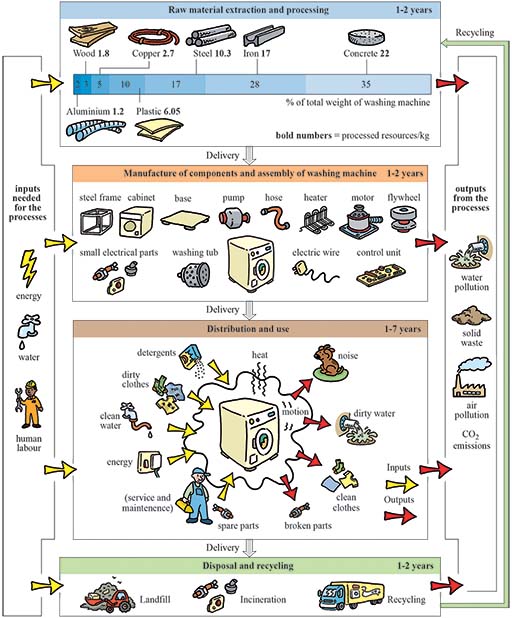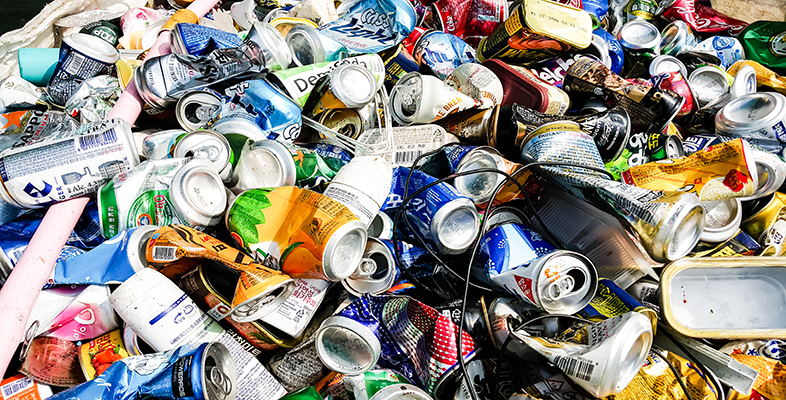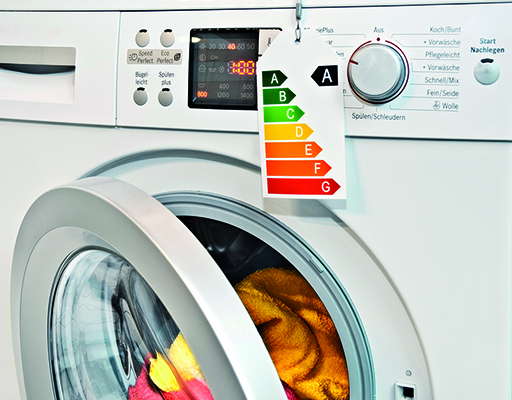1.3 Managing waste from cradle to grave – life-cycle assessment
The waste hierarchy provides some useful guiding principles for managing waste according to what is best for the environment. But does it always hold true? Imagine you have an old and energy-intensive appliance, say a clothes washing machine, but much more energy efficient washing machines are available to buy. Most appliances now come with some form of eco-labelling to indicate energy efficiency and help inform purchasers’ decisions (Figure 13).
Should you keep hold of your old energy-inefficient machine or buy a new energy-efficient one? Keeping it prevents it from becoming waste and seems like the most desirable option as it is at the top of the hierarchy. But this means you continue to use more energy than you need to. You could opt for reuse, the next best thing in the waste hierarchy, by passing your old machine on to someone else, but this will transfer the energy inefficiency elsewhere. The waste hierarchy, and the messages that flow from it, such as the ‘3Rs – reduce, reuse, recycle’ are not sufficient to help make this decision. What would also be helpful to understand is the energy use and other resource implications across the life cycles of the washing machines.
The life-cycle assessment (LCA, also known as ‘life-cycle analysis’) process considers all inputs and outputs that a product makes during its entire ‘life’ and is also sometimes informally referred to as cradle-to-grave analysis. It can be useful if you want to look at the possibilities of manufacturing products that are less harmful to the environment. A rigorous LCA would look at each stage of the product life, including raw materials acquisition, manufacturing, distribution and retail, use, reuse, maintenance, recycling, waste management and/or end-of-life phases (this is shown in Figure 14 for a new washing machine). The LCA process is particularly good for raising awareness of those additional undesirable outputs at each stage of the product life.
LCA is a systems approach in that it catalogues all of the environmental impacts for each stage of the life cycle. It starts from the impacts due to extraction of the raw materials and then continues to include the processing of these. Many manufacturers are acutely aware of the energy, materials and water required to make a product, and will attempt to reduce these inputs without sacrificing the function of the product. Reduction in manufacturing inputs makes good business sense, as lower inputs result in cost savings, which may result in higher profits for the firm, or lower prices for the public.
Next there is the in-use phase, which tends to have relatively high impacts, especially if the product requires energy, water or some other form of maintenance. The final phase is disposal and recycling. This phase may include dismantling for valuable components, depending on the item in question.
Many studies have shown that the LCA for the in-use phase of typical white goods attributes about 95% of the total impacts during the life cycle. Another 3–4% of the impacts occur for the assembly, and extraction and disposal each account for about 1%. Similar studies for many other goods have shown that the in-use phase accounts for the majority of emissions, especially if the item uses energy in some form, and for the majority of impacts produced. The in-use phase is sometimes called the operational phase, as the product should be working, being used or operated.

Carrying out a LCA can be far from straightforward. How do you allocate direct inputs such as electricity for operating machinery, lighting and warmth in a mass production factory to individual items or groups of products? Often this has to be a best guess as many factories do not measure electricity for each process or sub-process.
What about indirect inputs? Many large factories in China have accommodation, washing facilities, canteens and shops for their workers. All these require resources and create outputs in the form of waste food, packaging, waste water and sewerage. Should these indirect inputs and outputs be captured in the LCA?
What about indirect inputs in the operational phase? From the washing machine example above, should the emissions from the transport used by going to buy the detergent to use in the washing machine be included? This highlights one of the main LCA challenges, which is where to draw the boundary between what should and should not be included in the assessment.
Although it may be challenging to undertake, the advantage of a LCA is in identifying the environmental impacts of a product through all stages of its life. Once the impacts are known, initiatives to help reduce the impacts can be developed and implemented. LCA can also be used to compare different products and identify more environmentally-friendly ones. For example, LCA often underpins eco-labelling of products. Hence LCA can help improve the efficiency of the system, but the linear nature of the system remains the same – extraction, make, use, dispose – or ‘cradle-to-grave’. Although there can be reuse and recycling of some materials, this is after the in-use or operational stage. Critics argue that this linear system embeds the idea that these products were never ‘designed’ to be recycled, and as a result they tend to be recycled into poorer quality materials, which limits usability and maintains the linear flow (Ellen MacArthur Foundation, 2013).

